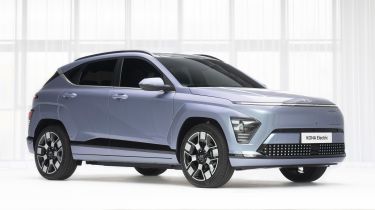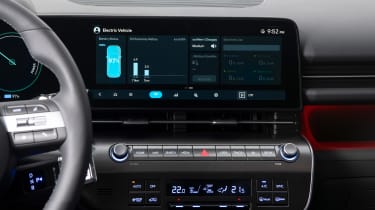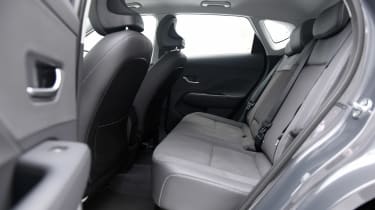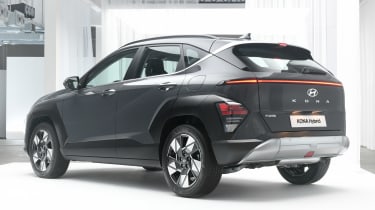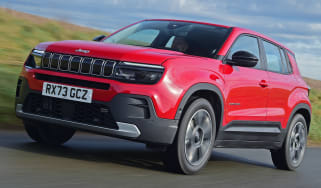New Hyundai Kona pricing revealed
The new Hyundai Kona starts from £25,725 and is available as a petrol mild-hybrid, self-charging hybrid or a full EV
- Kona will get mild-hybrid petrol, self-charging hybrid and EV versions
- Pricing starts from £25,725 for petrol mild-hybrid model
- Due on sale spring 2023
Hyundai has just released pricing for the mild-hybrid and full hybrid versions of the new Hyundai Kona, which will start from £25,725 and £30,025 respectively.
The South Korean firm has previously announced that the entry-level petrol and hybrid versions of the Kona will now be based on the flagship fully-electric version’s design, while the reverse was true of the previous model. However, the Hyundai Kona Electric will not launch alongside the combustion-engined models, and details for the electric version will be released early this summer.
The latest Kona will be larger than the first-generation model to provide more passenger and boot space, following customer feedback.
 Top 10 best hybrid SUVs in 2025
Top 10 best hybrid SUVs in 2025
The Hyundai Kona is one of the most important models in the South Korean brand’s lineup, and the latest iteration of Hyundai’s small SUV gets a striking exterior design and three different powertrain options: mild-hybrid, self-charging hybrid and fully electric.
Set to go on sale in spring 2023,, the new Hyundai Kona will renew its rivalry with Carbuyer’s Car of the Year, the Kia Niro – which shares the Kona’s underpinnings and is also available in plug-in hybrid form. Other significant competition includes the likes of the Renault Captur and Ford Puma, as well as the all-electric Renault Megane E-Tech and Volkswagen ID.3.
2023 Hyundai Kona: design, interior and technology
Mirroring what we expected from our pre-reveal render images, the new Hyundai Kona gets a revolutionary exterior design, characterised by a full-width front light bar dubbed the ‘Seamless Horizon Lamp’. There’s another light bar at the rear, too, while creases in the bodywork tie the Kona in with larger models in the Hyundai range such as the top-selling Tucson.
There will be four trim levels in total: Advance, N Line, N Line S and Ultimate. Advance models come with 17-inch alloy wheels (18-inch on full hybrid models), along with body-coloured door handles, mirrors, skid plates and spoiler. N Line and N Line S models get a sportier look with different front and rear bumpers, side skirts, 18-inch alloy wheels, twin exhaust tips, black door mirrors and roof, with body-coloured wheel arches. Ultimate models get full-width daytime running lights at the front and LED headlights.
The new Hyundai Kona’s interior is expected to look and feel more upmarket than the outgoing version. It has a light, minimalist design comprising neutral-colour fabrics and padded materials. Cabin highlights include a ‘single-vent’ dashboard design – like that found in the new Honda Civic – as well as a plethora of ambient lighting (N Line and above), reminiscent of the spectacular light show present in the Hyundai Ioniq 6.
Advance models start from £25,725, increasing to £27,525 for N Line. N Line S and Ultimate both start from £29,925; the former is the sporty choice whereas Ultimate takes the Kona in a more classy, premium direction, so it’s a matter of preference between slightly edgier styling or comfort-focused equipment.
Advance models get dual-zone climate control, front and rear parking sensors with a rear camera, keyless entry and dual 12.3-inch infotainment screens pulled from Hyundai’s all-electric range. This is compatible with Apple CarPlay and Android Auto as standard, and there are front and rear USB-C charging ports.
N Line models get sportier interior touches like aluminium pedals and N Line cloth seats front and rear. Other additions include ambient lighting, a powered tailgate, a heated steering wheel and wireless smartphone charging. N Line S adds Alcantara and leather upholstered heated and ventilated electrically-adjustable seats, plus three-zone air conditioning.
Top-of-the-line Ultimate models get black leather seats, a sunroof and an upgraded sound system, plus a memory and ‘Premium Relaxation’ function for the driver’s seat. Hybrid models get remote park assist – a feature that allows you to move the car back and forward with the smart key, making it easier to get in and out when parking.
The latest Kona is slightly larger than before (175mm longer and with the wheelbase stretched by 60mm), meaning rear passenger comfort and boot space should be improved over the outgoing car, which were the main gripes expressed by the original model’s owners. In fact, the original Kona’s 332-litre boot space has increased to 466 litres in the new model – that’s almost on par with the Kia Niro EV. The Kona will also get a waterproof storage box under its bonnet that’s ideal for charging cables.
Range, power and specs
Like its mechanical sibling the Kia Niro, the new Hyundai Kona will be available with mild-hybrid petrol, self-charging hybrid and fully-electric power. However, unlike the Kia, the Kona won’t be offered as a plug-in hybrid – instead, all versions of the Kona can be had with a mild-hybrid assisted 1.0-litre 118bhp, and a mild-hybrid turbocharged 1.6-litre 195bhp petrol engine can be specified on N Line S and Ultimate models. Both of these can be paired with a manual or automatic transmission. Full hybrid versions of the Hyundai Kona use a 1.6-litre engine paired with an electric motor to produce 139bhp through a six-speed automatic gearbox.
Although full details of the Hyundai Kona Electric are to be released this summer, the Long Range version will get a 65.4kWh battery and a 215bhp motor at the front, delivering up to 305 miles on a charge – a standard range version is also expected with a 154bhp electric motor and 48.4kWh battery and a range of up to 213 miles. Charging times will be slower than that of the Ioniq 5, however, as it’s based on 400-volt tech, compared with the Ioniq 5’s 800-volt system. While precise figures haven't been released yet, a fast charge to 80% is still likely to take well under one hour.
What does this mean for car buyers?
The arrival of the new Kia Niro left little reason for buyers to choose the Hyundai over its Kia sibling. However, the arrival of a new model with the latest tech and an entry-level mild-hybrid petrol engine means the Kona could be an appealing choice once again, particularly for private buyers.
The mild-hybrid and full hybrid models will go on sale in late spring 2023, with the electric model on which they’re based arriving a few months later. There’s no official word on pricing yet, but entry-level models could cost around £22,500 – undercutting the equivalent Ford Puma. Self-charging hybrid models will likely start from around £30,000 and will appeal to higher-mileage drivers. The electric Kona is expected to cost from £38,000 and will go down especially well with company car drivers, thanks to its very low Benefit-in-Kind tax band.
Want to see what other options are out there? Check out our list of the top 10 best small SUVs
Recommended
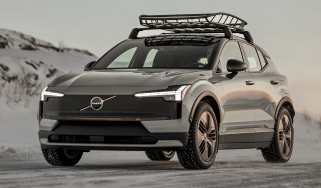
Rugged Volvo EX30 Cross Country arrives with £47k price tag
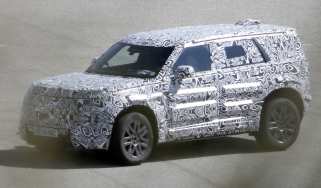
New Land Rover Defender Sport spotted and it’s an electric baby SUV
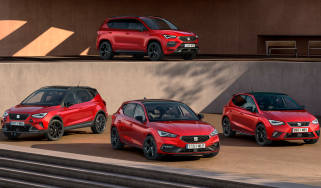
SEAT releases new Black Edition models with sportier styling
Most Popular

New Smart #5 Brabus is a 637bhp far cry from the brand’s city car past

Best car leasing deals 2025: this week’s top PCH offers
Tips & advice

Car dashboard warning lights: what does each symbol mean?

Electric car charging stations: public networks, charger types, apps and maps

